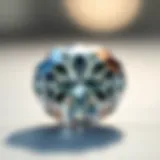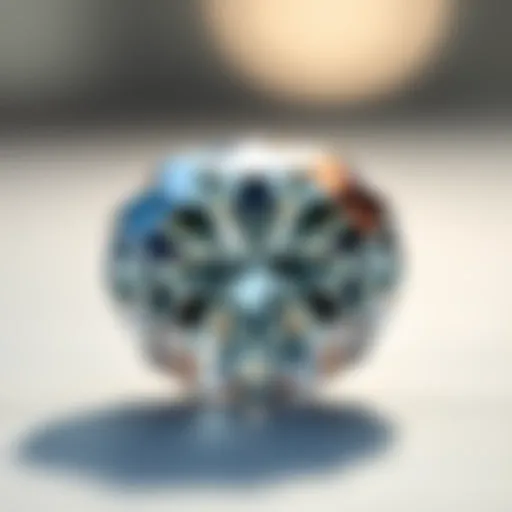How to Test the Authenticity of a Diamond Ring


Intro
Determining the authenticity of a diamond ring is a significant skill for both collectors and casual jewelry buyers. Diamonds, often considered the ultimate symbol of love and commitment, can also be subject to imitation and deceit. This article will explore various methods to test the authenticity of a diamond ring, ensuring that you are equipped with the necessary knowledge to make informed decisions.
In this guide, you will learn about the fundamental characteristics of diamonds, the practical tests that can be performed at home, and the advanced evaluations used by professionals. Understanding these aspects is crucial for anyone looking to invest in a diamond or secure its value over time.
Gemstone Overview
Description of the gemstone
Diamonds are formed deep within the Earth's mantle under immense pressure and heat. They are composed of carbon atoms arranged in a crystal structure known as cubic. This unique formation is what gives diamonds their remarkable durability and impressive brilliance.
Diamonds come in various colors, with the most sought-after stones being colorless, referred to as white diamonds. However, colored diamonds, such as blue, yellow, and pink, also possess their own allure and can fetch high prices in the market.
Physical properties
Diamonds are known for several distinctive physical properties:
- Hardness: Diamonds score a 10 on the Mohs scale, making them the hardest natural material on Earth.
- Refraction: The unique optical properties lead to exceptional light dispersion, giving a diamond its characteristic sparkle.
- Thermal conductivity: Real diamonds conduct heat much better than most simulants, meaning they will feel cooler to the touch.
Understanding these properties is essential for assessing the authenticity of a diamond. By recognizing how genuine diamonds differ in these aspects compared to imitations, one can better navigate the jewelry market.
Important: Familiarizing yourself with diamond characteristics is foundational in distinguishing real stones from imitations.
Practical Tests for Authenticity
When faced with the task of verifying a diamond ring, several practical at-home tests can be performed. These methods can help you determine if a diamond is genuine before seeking professional evaluation. Here are a few.
- The Fog Test: Breathe on the stone. If the fog dissipates within a second, it is likely a real diamond. Simulants retain moisture longer.
- The Water Test: Drop the diamond in a glass of water. A genuine diamond will sink. Many fakes will float or hover in the water.
- The Scratch Test: This is a more risky test; however, real diamonds will scratch glass with no damage to themselves, while many fakes will show signs of wear.
While home tests can provide some assurance, they are not foolproof. It is advisable to follow up with professional assessments to confirm authenticity.
Advanced Laboratory Evaluations
For a more definitive understanding of your diamond’s authenticity, laboratory evaluations are highly recommended. A few notable methods include:
- Certification: Reliable stones should come with a certificate from a reputable grading entity like the Gemological Institute of America (GIA) or the American Gem Society (AGS).
- Spectroscopy: This method analyzes light waves to reveal the diamond's internal characteristics.
- X-ray fluorescence: This can determine the diamond’s elemental composition, helping to identify if a stone is genuine.
End
Prelude to Diamond Authenticity
Understanding diamond authenticity is critical for anyone engaged in the gemstone market—be it collectors, enthusiasts, or those seeking to design exquisite jewelry. Diamonds have an allure that extends far beyond their aesthetic value; they symbolize love, commitment, and status. However, the presence of a robust marketplace for imitations and synthetics necessitates a thorough approach to verify a diamond's genuineness.
The importance of diamond authenticity lies in several key elements. First, authentic diamonds carry significant financial value, and distinguishing them from imitations helps avoid monetary losses. Secondly, the emotional value tied to diamonds, particularly in engagement rings, prompts buyers to seek assurance that their purchase is genuine.
From the perspective of quality, genuine diamonds possess unique characteristics resulting from their natural formation process. These features, including inclusions, cut, and light performance, often set authentic diamonds apart from synthetics or simulants. Recognizing these elements can empower buyers, guiding them toward informed decisions in their purchasing journey.
In this article, we will discuss various approaches to testing diamond authenticity, from simple home methods to advanced lab evaluations. > "Education is the first step toward ensuring that you invest wisely in one of nature's rarest treasures."
Moreover, certification plays a vital role in establishing authenticity. Accredited gemological laboratories provide detailed analyses that assure buyers of the quality and origin of their diamonds. Understanding the weight of certification will be explored in later sections.
In summary, grasping the nuances of diamond authenticity is a multi-faceted endeavor. With the right knowledge, you enhance your ability to appreciate these remarkable gemstones without falling victim to deceptive alternatives.
Understanding Diamonds
In this section, we will explore the significance of understanding diamonds. A comprehensive knowledge of diamonds is essential for various reasons, especially for those looking to invest in these precious stones. Genuine diamonds possess unique attributes that set them apart from imitations. Recognizing these qualities can prevent costly mistakes and ensure that individuals purchase what they believe they are acquiring.
When one understands how diamonds form and their inherent properties, it becomes easier to appreciate their value. This knowledge offers a clearer lens through which to view the intricacies of the diamond trade, enabling buyers to make informed decisions. Furthermore, understanding diamonds can also enhance one's enjoyment of wearing or gifting these gems, adding an extra layer of significance to the purchase.
Formation and Properties
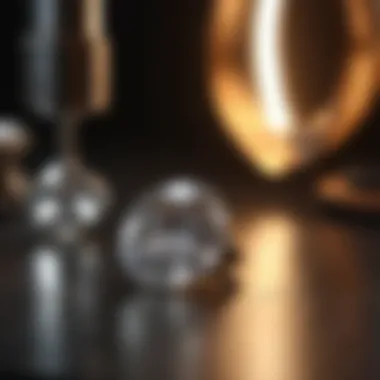

Diamonds are formed deep within the Earth under extreme heat and pressure, typically at depths of 150 to 200 kilometers. This natural process can take millions to billions of years. During this time, carbon atoms bond in a unique crystalline structure, giving diamonds their exceptional hardness.
A key property of diamonds is their brilliance, derived from how they refract light. The combination of cut, color, clarity, and carat weight defines the overall quality and value of a diamond. Understanding these properties helps buyers assess the worth of a diamond ring more critically.
Diamond vs. Imitations
Identifying genuine diamonds from imitations is crucial for any potential buyer. Imitations vary widely in terms of material and quality. Common imitations include cubic zirconia, moissanite, and glass, each having distinct properties that differ significantly from natural diamonds.
- Cubic Zirconia: Often regarded as the most popular diamond substitute, cubic zirconia is synthetic and can sometimes appear very similar to diamonds. However, they lack the same light dispersion and hardness.
- Moissanite: This is another popular diamond alternative that has its own set of properties. Moissanite actually has a greater fire and brilliance than diamonds but is often more affordable.
- Glass: Some rings may look shiny but are simply made from glass. While they can be beautiful, they do not share the durability or value of real diamonds.
Understanding the differences between diamonds and their imitations is essential for anyone wanting to ensure they are buying a genuine piece. This knowledge serves as a safeguard against poor purchases.
Basic Tests for Diamond Identification
When it comes to determining the authenticity of a diamond ring, performing basic tests is crucial. These methods allow individuals to quickly assess whether a stone is a true diamond or a less valuable imitation. Basic tests can be done at home without specialized equipment and provide initial indicators of authenticity. They guide potential buyers and owners alike in making informed decisions about their purchases. Moreover, these tests can help prevent costly mistakes, especially since the market is flooded with synthetic and imitation stones that look remarkably similar to genuine diamonds.
The Water Test
The water test is a simple yet effective method used to differentiate a diamond from other gemstones. To perform this test, take a clear glass of water and drop the ring into it. A real diamond will sink quickly and remain at the bottom due to its density. On the other hand, most imitations tend to float or rest near the surface, primarily because they are lighter than a true diamond. This test is relatively straightforward and does not require any specialized tools.
The Fog Test
The fog test exploits the unique thermal properties of diamonds. To perform this test, breathe on the diamond, creating a foggy film on its surface. A genuine diamond has excellent heat dispersion, meaning that the fog will dissipate almost immediately. If the fog lingers for more than a few seconds, it is likely that the stone is not a diamond, as simulants like cubic zirconia and glass do not have the same thermal conductivity.
The Scratch Test
For the scratch test, an individual can assess the hardness of the gemstone. Diamonds are known as the hardest natural material, rated a 10 on the Mohs scale. Using a material that is softer than a diamond, such as glass, gently attempt to scratch the stone. A true diamond will not scratch, whereas an imitation may show signs of scratching or damage. However, caution should be taken, as this test can also damage the diamond if not conducted carefully. It's advisable to use this test sparingly and consider the potential risks to your valuable jewelry.
Through these basic tests, individuals can gain insight into the authenticity of their diamond rings. While these methods are not foolproof, they serve as a useful starting point for anyone curious about the quality and legitimacy of their gems. Buyers are encouraged to follow up with professional evaluations if any doubt remains.
Utilizing Tools for Testing Diamonds
First, the use of specific tools can help a person identify the unique properties of a diamond. For instance, tools like a loupe or a diamond tester can reveal details that are not visible to the naked eye. The benefits of incorporating tools into the authentication process are noteworthy. They help in making informed choices and provide validation of the investment made in the diamond ring.
Considerations about these tools include the frequency of use, as well as the cost and accessibility. While some tools are designed for occasional use, others may require an investment. However, having reliable tools can save money and time in the long run when purchasing diamonds or inspecting existing stocks.
"Investing in tools for testing diamonds can greatly enhance one's expertise and confidence in gemstone evaluation."
Using a Loupe
A loupe is an essential instrument for anyone serious about assessing diamonds. This handheld magnifying glass is particularly useful for examining the clarity and cut of a diamond. By magnifying the stone, users can inspect for any inclusions or blemishes which are characteristic of natural diamonds.
The magnification power of a typical loupe is around 10x, which allows for detailed observation. Users can easily see how light interacts with the diamond, revealing its brilliance and fire. When examining the stone, it is important to hold the loupe close to the eye while focusing on the diamond. This technique yields the best results.
Ultimately, using a loupe is a straightforward method that adds clarity to the authentication process. It helps distinguish real diamonds from synthetic options, as imitations often lack the same unique internal characteristics.
Diamond Tester Devices
Diamond tester devices provide another level of certainty in determining a diamond's authenticity. These handheld tools measure the thermal conductivity of a stone. Genuine diamonds disperse heat differently than synthetic stones or other materials.
To use a diamond tester, a person places the tip of the device against the diamond. Following a few seconds of assessment, the device will signal whether the stone is a genuine diamond or not. One must ensure that the device is calibrated correctly for accurate results.
The convenience of diamond testers makes them a popular choice among jewelers and gem enthusiasts. For those who require quick verification, this device is invaluable. Investing in a reliable diamond tester can aid in eliminating doubts about a stone's authenticity efficiently.
In summary, utilizing tools like loupes and diamond testers significantly enhances one's ability to ascertain the authenticity of diamond rings. These instruments are not just accessories; they are vital components of effective diamond evaluation.
Professional Evaluation
Professional evaluation is a critical step in confirming the authenticity of a diamond ring. Such assessments go beyond the basic tests that can be performed at home, offering a level of certainty that casual methods may not provide. This section will explore the significance of professional evaluations in ensuring buyers receive genuine diamonds rather than imitations.
The main elements of professional evaluation include the use of advanced equipment and expertise in gemology. Trained gemologists possess a deep understanding of diamond characteristics, including clarity, carat, cut, and color, known collectively as the "Four Cs." These experts can efficiently identify whether a diamond is real or synthetic, dramatically reducing the risk of purchasing a flawed or fake stone.
Several benefits stem from opting for a professional evaluation:
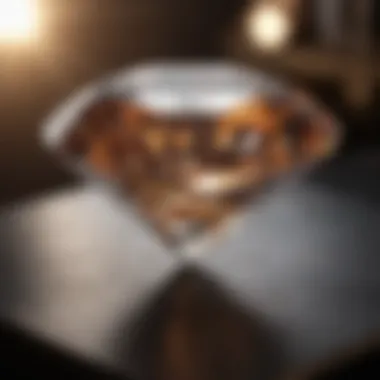

- Technical Knowledge: Gemologists use their extensive training to differentiate between real diamonds and their imitations, such as cubic zirconia or moissanite.
- Advanced Equipment: Instruments like spectroscopes and refractometers provide data that are not accessible via casual tests, leading to a more accurate diagnosis.
- Certification: Diamonds that have been evaluated professionally often come with certificates that provide proof of authenticity and details about their characteristics. This is particularly useful for those considering future resale of their jewelry.
A thorough evaluation considers numerous factors, including the diamond's provenance and the ethical implications of its sourcing. As consumers become more conscious of ethical sourcing, a professional evaluation can assure buyers that their diamond is conflict-free.
"Investing in a professionally evaluated diamond ring is not just a purchase; it’s a commitment to quality and authenticity."
Thus, seeking professional evaluation not only enhances the buyer’s confidence in their decision but also underscores the importance of having reliable verification when dealing with precious items like diamond rings.
Certification Importance
Certification plays a pivotal role in the professional evaluation of diamonds. A certificate, often issued by a reputable gemological laboratory, attests to the diamond's quality and characteristics through rigorous examination methods. Well-known institutions like the Gemological Institute of America (GIA) or the American Gem Society (AGS) are highly regarded for their thorough grading processes.
When a diamond is certified, it generally includes important details that inform potential buyers about:
- The diamond's carat weight
- Cut quality
- Color grade
- Clarity level
Having a certified diamond instills trust, serving as a safeguard against deception. For those invested in quality gemstones, this documentation can significantly enhance value when reselling or passing down an heirloom. Buyers can be assured that what they are acquiring has been proactively assessed and assigned its proper standing in terms of quality.
Gemological Laboratory Tests
Gemological laboratory tests provide a comprehensive and scientific method for verifying diamonds. These tests are far more sophisticated than any surface checks that individuals may perform at home. Laboratories employ a range of assessments that yield reliable results.
Some common tests conducted by gemological laboratories include:
- Spectroscopy: This technique helps identify the specific elements present within the gemstone, determining its authenticity.
- Refractive Index: Instruments measure how a diamond refracts light, distinguishing it clearly from fake stones.
- Fluorescence Tests: These tests reveal how a diamond reacts to ultraviolet light, providing additional insight into its authenticity.
The results of these extensive tests contribute to an officially recognized report. Buyers can compare this report against their own evaluations or those of other professionals. As such, making a decision based on empirical evidence not only protects a diamond purchase but also enhances the overall understanding of the asset.
Professional evaluations combining certifications and laboratory tests create a reliable framework for assessing the authenticity of diamonds, ensuring that buyers can make informed and confident choices.
Signs of Authenticity
When evaluating a diamond ring, understanding the signs of authenticity is crucial. Authentic diamonds exhibit specific characteristics that differentiate them from imitations. Recognizing these signs can save you from poor investments and enhance your appreciation of the jewel's inherent value. This section will delve into two key aspects: inclusions and clarity, along with cut and light performance.
Inclusions and Clarity
Inclusions are natural imperfections found within a diamond. They can be tiny minerals, other gemstones, or even air bubbles trapped during the diamond's formation. These inclusions serve as fingerprints for genuine diamonds, meaning each diamond is unique.
Clarity, on the other hand, refers to the absence of these flaws. A diamond with higher clarity is usually more valuable. However, it's essential to note that while inclusions might lower a stone's price, they can also enhance its character. Many gemstone enthusiasts appreciate natural variations, viewing them as a testament to a diamond's authenticity.
When examining the ring, use a jeweler's loupe or a magnifying glass to identify inclusions. Look for:
- Feathers: Small cracks that resemble feathers.
- Crystals: Tiny, included minerals.
- Clouds: Groups of tiny inclusions that create a hazy appearance.
These inclusions should be present but not overly. A diamond is usually graded on a scale from Flawless to Included, with specific grading systems used by gemological institutes.
Cut and Light Performance
The cut of a diamond significantly impacts its overall appearance and light performance. A well-cut diamond reflects and refracts light differently than an off-cut one. The angles and proportions of the facets determine how light interacts with the diamond, thus influencing its brilliance and fire.
Key aspects to consider in cut include:
- Symmetry: Edges must be equal and aligned precisely.
- Proportions: The ratio of the diamond's width to its height should be optimal.
- Polish: A diamond must be polished well to enhance light reflection.
Light performance is vital. When a diamond is cut correctly, it will sparkle beautifully under various light sources. An authentic diamond will exhibit a stunning combination of brilliance, which is the white light reflected, and fire, which refers to the colorful flashes.
To assess cut and light performance:
- Observe the diamond in different lighting conditions to see how it reacts.
- Check if the light returns directly to the viewer’s eye rather than leaking out the sides.
"The interaction of light and the diamond's cut is what makes it enchanting."
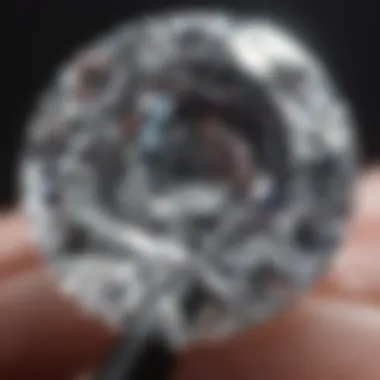

Common Misconceptions
The subject of diamond authenticity is riddled with misconceptions that can lead to costly mistakes for buyers and enthusiasts. Understanding these misconceptions is crucial for anyone who seeks to acquire a diamond ring. This section sheds light on common myths and misunderstandings that permeate discussions about diamond testing and imitation stones. By clarifying these points, we aim to empower readers with accurate knowledge and promote informed decision-making.
Myths about Diamond Tests
Many people believe that identifying a diamond's authenticity is straightforward, relying on easily conducted tests that anyone can perform. One common myth is that all diamonds can be tested using simple household methods like the scratch test or fog test alone. While these tests can provide initial insights, they are not foolproof.
A prevalent assumption is that a diamond should be impervious to scratching or damage. In reality, although diamonds are among the hardest natural materials, they can still chip if they are hit at the right angles. Therefore, relying solely on scratch resistance for authenticity can mislead even the savvy buyer.
Furthermore, there's a misconception that a diamond's brilliance or sparkle guarantees its authenticity. While genuine diamonds exhibit exceptional light performance, other stones, such as cubic zirconia, can mimic this effect to some extent. The visual allure of a gemstone does not confirm its identity; testing with proper tools or consulting a professional provides more reliable results.
Misunderstanding Imitations
Similarly, there is confusion surrounding diamond imitations. Many believe that all imitations are of inferior quality and entirely different from real diamonds. However, this overlooks the existence of high-quality lab-created diamonds and simulants that can closely imitate the appearance and optical properties of a natural diamond.
Some buyers mistakenly categorize stones like moissanite as inferior alternatives. In reality, moissanite is a legitimate gemstone with unique qualities and brilliance that can rival that of diamonds. This misunderstanding can lead to the dismissal of valuable gems simply based on misinformation.
Moreover, consumers often associate the term "conflict diamonds" with all diamonds sold today. While concerns about ethical sourcing are valid, not all diamonds are subject to these issues. Modern certification and responsible sourcing efforts have made it easier to find ethically mined gems; being aware of such distinctions is crucial.
"Understanding the nuances between diamonds and their imitations requires education and careful evaluation."
In summary, clearing up these myths and misunderstandings not only enhances the knowledge base of collectors and enthusiasts but also aids in navigating the complex world of diamond authenticity. By addressing these misconceptions, we equip readers to make more sound and informed choices when purchasing or evaluating diamond rings.
Caring for Your Diamond Ring
Caring for a diamond ring is not just an issue of aesthetics, but it is pivotal to maintaining its integrity and overall brilliance. A diamond, with its exceptional hardness, still requires proper attention to preserve its beauty. Neglecting regular maintenance can lead to dirt buildup and diminishment of its sparkle. Additionally, understanding how to care for a diamond ring keeps it looking new and enhances its longevity.
Regular Cleaning Practices
Regular cleaning is essential for your diamond ring. Dirt, oil, and other residues accumulate on the surface, dulling its shine. For at-home cleaning, you can use a combination of warm water and mild dish soap. Soaking the ring for a few minutes allows the grime to loosen. After soaking, gently scrub it with a soft-bristled toothbrush, particularly in crevices where dirt may hide.
- Materials you need:
- Warm water
- Mild dish soap
- Soft toothbrush
- Lint-free cloth
Rinse the ring thoroughly under running water for a clean finish. Ensure you close the drain or use a bowl to catch the ring, preventing any accidental loss. After rinsing, dry it gently with a lint-free cloth. Regular cleaning should be done every few weeks, depending on usage. This keeps the diamond radiant and prevents any long-term buildup.
Safe Storage Tips
When not worn, safe storage of your diamond ring is crucial. A proper storage routine protects against scratches and potential damage from environmental factors.
- Keep it Separate: Store your diamond ring in a soft pouch or in a jewelry box with compartments. This prevents it from rubbing against other jewelry.
- Avoid Extremes: Protect the ring from extreme temperatures and humidity, which can impact its settings or cause damage over time.
- Use Anti-Tarnish Materials: Consider using anti-tarnish strips or cloths in your storage box to prevent tarnishing of any metal settings.
Important Reminder: When storing a diamond ring, always ensure it is clean. Storing a soiled ring can lead to further damage due to the trapped dirt and oil which can impact its setting.
"Regular maintenance of your diamond ring will ensure that it remains as breathtaking as the day you received it."
Each of these tips maximizes the beauty and longevity of your diamond ring, allowing you to enjoy it for many years while maintaining its unmatched brilliance.
Ending
In the realm of jewelry, especially diamond rings, understanding authenticity is paramount. The conclusion of this article serves not only as a summary of the key points discussed but also as a reflection on the significance of discerning real diamonds from their imitations.
First, it is essential to recognize the various methods available for testing diamonds. From simple at-home tests like the water test and fog test, to professional evaluations conducted in laboratories, each technique has its merits. These methods empower individuals to make educated decisions, whether purchasing a ring for oneself or gift.
With growing interest in diamonds, the market has seen an increase in imitations. Knowing how to test authenticity offers assurance, both financially and emotionally, as it protects buyers from scams that can tarnish the joy of such an investment.
Furthermore, the role of certification becomes critical. A diamond with a reputable certification carries more weight than one without. It not only validates the stone's authenticity but also contributes to its value over time. Understanding certification processes and being able to interpret them ensures consumers are well-informed when selecting their precious jewelry.
Moreover, recognizing signs of authenticity—such as natural inclusions and light performance—is crucial. These distinct features differentiate genuine diamonds from imitations. The subtleties in these characteristics can often go unnoticed, meaning a careful examination is beneficial.
Lastly, addressing the misconceptions surrounding diamonds plays a vital role in educating prospective buyers. By clarifying myths and misunderstandings, consumers can approach the market with a clearer perspective.
In summary, concluding an understanding of how to authenticate a diamond ring emphasizes the need for informed choices. The information presented throughout this article equips readers with the knowledge necessary to navigate the complexities of diamond purchasing. This empowers them to cherish the unique aspects of genuine diamonds and appreciate their true value.
"An informed buyer is a responsible buyer. Understanding authenticity safeguards both financial and emotional investments."
Embracing the steps outlined in this guide can lead to confident purchases, ensuring that the beauty and significance of a diamond ring are not merely superficial but backed by authenticity.




